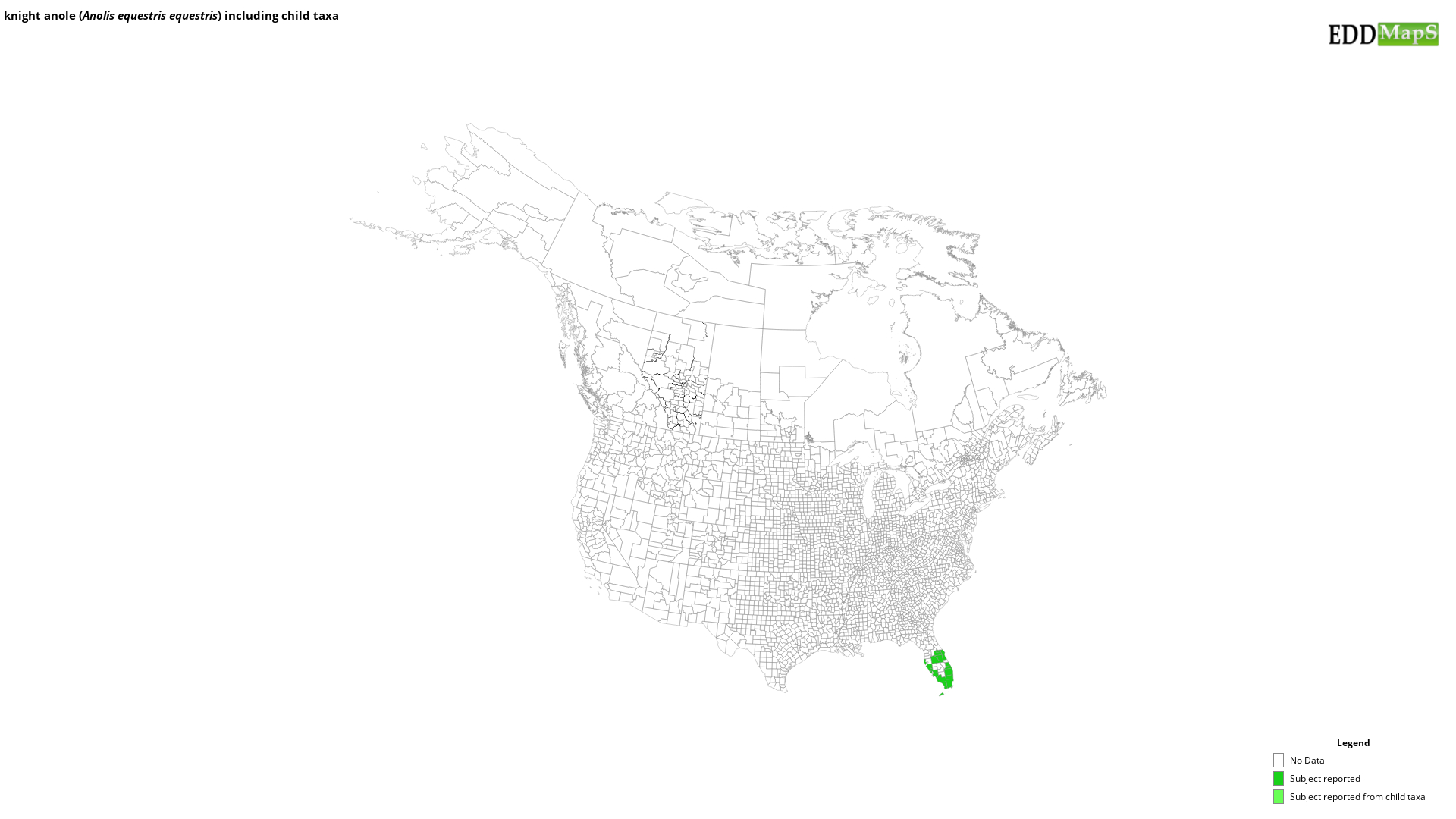knight anole
(Anolis equestris equestris)
This species is Introduced in the United States
Origin
Anolis equestris is native to Cuba. Knight anole were introduced to the United States through the pet trade.
Life Cycle
Bright green in color, both sexes possess a pink dewlap and yellow stripes below the eyes and onto the shoulder. There is sexual dimorphism with males changing color to a dull grayish-brown. Knight anoles are the largest of the Anolis spp. with males slightly larger than females with sizes of 13-20 in. (33-51 cm) in length. Knight anole breed once yearly in the summer months. Little is known about the breeding behavior of A. equestris. Knight anoles are diurnal.
Distribution
A. equestris distributions are confined by temperature as they cannot tolerate cold temperatures. Knight anole were introduced into the southeastern sections of Florida with current breeding populations in 11 counties.
Control Efforts
Avoiding the transportation of A. equestris is key to reducing its spread. Little can be done for established, breeding populations.
If you choose to have a knight anole as a pet in Florida, do your research before buying and remember, Don’t Let It Loose! Surrender unwanted exotic pets at one of FWC’s Exotic Pet Amnesty Day events or call the Pet Amnesty hotline at 1-888-IVE-GOT1.
http://www.iucngisd.org/gisd/species.php?sc=1619
https://animaldiversity.org/accounts/Anolis_equestris/
https://fl.audubon.org/news/species-spotlight-knight-anole
Anolis equestris is native to Cuba. Knight anole were introduced to the United States through the pet trade.
Life Cycle
Bright green in color, both sexes possess a pink dewlap and yellow stripes below the eyes and onto the shoulder. There is sexual dimorphism with males changing color to a dull grayish-brown. Knight anoles are the largest of the Anolis spp. with males slightly larger than females with sizes of 13-20 in. (33-51 cm) in length. Knight anole breed once yearly in the summer months. Little is known about the breeding behavior of A. equestris. Knight anoles are diurnal.
Distribution
A. equestris distributions are confined by temperature as they cannot tolerate cold temperatures. Knight anole were introduced into the southeastern sections of Florida with current breeding populations in 11 counties.
Control Efforts
Avoiding the transportation of A. equestris is key to reducing its spread. Little can be done for established, breeding populations.
If you choose to have a knight anole as a pet in Florida, do your research before buying and remember, Don’t Let It Loose! Surrender unwanted exotic pets at one of FWC’s Exotic Pet Amnesty Day events or call the Pet Amnesty hotline at 1-888-IVE-GOT1.
http://www.iucngisd.org/gisd/species.php?sc=1619
https://animaldiversity.org/accounts/Anolis_equestris/
https://fl.audubon.org/news/species-spotlight-knight-anole
Selected Images
Maps
EDDMapS Distribution - This map is incomplete and is based only on current site and county level reports made by experts, herbaria, and literature. For more information, visit www.eddmaps.org
State Lists - This map identifies those states that have this species on their invasive species list or law.
Invasive Listing Sources
Taxonomic Rank
| Domain: Eukarya |
| Kingdom: Animalia |
| Phylum: Chordata |
| Class: Reptilia |
| Order: Squamata |
| Family: Dactyloidae |
| Genus: Anolis |
| Species: Anolis equestris |
| Anolis equestris equestris |
References
Common Name Reference: Web Search - http://www.tigr.org/reptiles/species.php?genus=Anolis&species=equestris
Scientific Name Reference: Web Search - http://www.tigr.org/reptiles/species.php?genus=Anolis&species=equestris


